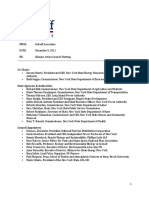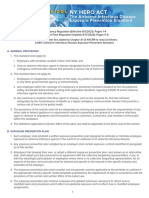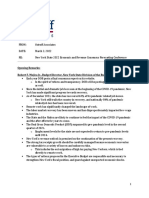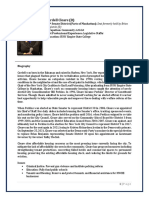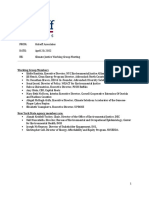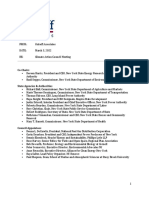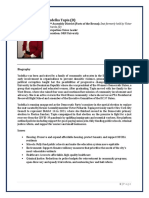Professional Documents
Culture Documents
DLTC Covid-19 Guidance 3-18-20
Uploaded by
OA0 ratings0% found this document useful (0 votes)
113 views9 pagesGuidance for the Authorization of Community Based Long-Term Services and Supports Covered by Medicaid
Original Title
Dltc Covid-19 Guidance 3-18-20
Copyright
© © All Rights Reserved
Available Formats
PDF or read online from Scribd
Share this document
Did you find this document useful?
Is this content inappropriate?
Report this DocumentGuidance for the Authorization of Community Based Long-Term Services and Supports Covered by Medicaid
Copyright:
© All Rights Reserved
Available Formats
Download as PDF or read online from Scribd
0 ratings0% found this document useful (0 votes)
113 views9 pagesDLTC Covid-19 Guidance 3-18-20
Uploaded by
OAGuidance for the Authorization of Community Based Long-Term Services and Supports Covered by Medicaid
Copyright:
© All Rights Reserved
Available Formats
Download as PDF or read online from Scribd
You are on page 1of 9
NEWYORK | Department
afetiu. | of Health
ANDREW M. CUOMO HOWARD A. ZUCKER, M.D., J.D. SALLY DRESLIN, M.S., R.N.
Governor Commissioner Executive Deputy Commissioner
March 18, 2020
Re: COVID-19 Guidance for the Authorization
of Community Based Long-Term Services
and Supports Covered by Medicaid
‘The New York State Department of Health (NYSDOH) is providing this guidance to
Medicaid Managed Care Plans, Local Departments of Social Services (LDSS), and Consumer
Directed Personal Assistance Program (CDPAP) pertaining to the current novel coronavirus
(COVID-19) outbreak. The guidance applies to Medicaid covered services as described below
when delivered through either Licensed Home Health Care Services Agencies or CDPAP.
Topics include: (1) physician orders; (2) the initial Community Health Assessment; (3)
‘Community Health Reassessments; (4) Annual Health Assessments for Personal Assistants;
and (5) Facility-Based Assessments. Guidance provided herein should be shared by CDPAP.
Fiscal Intermediaries with Consumers and by Consumers with their Personal Assistants. This
guidance is provided in light of the COVID-19 outbreak and the state disaster emergency
declared by Executive Order No. 202 and shalll remain in effect until subsequent notice from
the NYSDOH which will be provided prior to or upon the expiration of such state disaster
emergency,
Background
The health and safety of the State’s health care workforce and our ability to provide
and support patient care remain our priorities. Recently, community-wide transmission of
COVID-19 has occurred in the United States (US), and the number of both Persons Under
Investigation (PUls) and confirmed cases are increasing in NYS. The situation with COVID-19
infections identified in the US continues to evolve and is very rapidly changing. It is important
for all agencies, Medicaid Managed Care Plans, LDSS and Consumer Directed Personal
Assistance Program (CDPAP) consumers keep apprised of current guidance by regularly
Visiting the Centers for Disease Control and Prevention (CDC) and NYSDOH websites, as
well as the NYSDOH Health Commerce System (HCS), for the most up-to-date information for
healthcare providers.
© CDC: https://www.cde.gov/coronavirus/2019-neov/index. html
* NYSDOH: https://www.health.ny gov/diseases/communicable/coronavirus
* HGS: https://commerce health.state.ny.us
Itis important to keep staff, enrollees, and Consumers updated as the situation
changes and educate them about the disease, its signs and symptoms, and necessary
infection control to protect themselves and the people they serve. NYSDOH distributes alerts
and advisories on its website and, therefore, itis vital that all organizations maintain up-to-
date contact with both the CDC and NYSDOH. Additionally, Medicaid Managed Care Plans,
LDSS and CDPAP Consumers may wish to provide internal contact information for their staff,
enrollees and Consumers, as applicable, to call with concerns, reports or questions.
Empire State Plaza, Corning Tower, Albany, NY 12237 |heath.ny.gov
Guidance
1
Physician Order: Initial authorizations for Personal Care Services (PCS) and
Consumer Directed Personal Assistance Services (CDPAS) will continue to require a
physician order. Pursuant to applicable state regulations, the physician's order
documents the medical examination that assess an individual's needs for PCS or
CDPAS and describes the patient's medical condition and regimes and the patient's,
need for assistance with personal services tasks, Based on this information, the
physician must certify as part of the order that the patient is able be cared for at home.
To promote compliance with CDC and NYSDOH guidance and avoid unnecessary
exposure to COVID-19, effective immediately, and until further notice is provided by
NYSDOH, the ordering physician is encouraged to use the telephone or permitted
telehealth modalities in connection with completion of the required physician order.
Physicians should consult with applicable provisions of NYSDOH's recently issued
special guidance on the use of telehealth for a description of permitted telehealth
modalities
httos:/www.health.ny.govihealth_care/medicaid/erogram/update/2019/2019-
02_speced.htm).
Initial Community Health Assessment: Initial authorizations for PCS, CDPAS, and
other community based long term services and supports (CBLTSS) (ie., nursing
services in the home, therapies in the home, home health aide services, adult day
health care, and private duty nursing) and requests for changes in service
authorizations, will continue to require a completed Community Health Assessment
(CHA). To promote compliance with CDC and NYSDOH guidance and avoid
unnecessary exposure to COVID-19, effective immediately, and until further notice is
provided by NYSDOH, registered nurses may conduct the CHA by telephone or
permitted telehealth modalities, as described in the applicable provisions of the
Telehealth Guidance. During this time period, CHAs conducted by telephone or
telehealth, which would otherwise require a face-to-face assessment to be fully
completed, may be used to develop an initial plan of care for the recipient and to
authorize necessary CBLTSS, both through fee-for-service and Medicaid managed
care.
Notwithstanding the ability to conduct a CHA by telephone or through telehealth,
eligibility requirements and standards for services and Managed Long-Term Care
(MLTC) plan enrollment are not being changed. To that end, a CHA conducted by
telephonic or through telehealth, but that cannot be fully completed (e.g,, the functional
assessment) may not be used to determine initial eligibility for members to enroll in
MLTC plans. Until such time as the CHA may be fully completed, the member's LDSS
will develop and monitor the plan of care. Additionally, this guidance does not preclude
‘completion of a full CHA and enrollment in an MLTC if consistent with CDC and
NYSDOH guidelines. For individuals already enrolled of newly enrolled in a
Mainstream, HIV-SNP or HARP Medicaid Managed Care plan, the member's plan will
remain responsible for completing the CHA and monitoring the plan of care.
Reassessments and Home Visit: Effective immediately, and until further notice,
NYSDOH is suspending all required periodic re-assessments of CHAS through
Medicaid managed care (including MLTC) or fee-for-service Medicaid. In addition, the
six-month in-person care management home visit requirement is also suspended.
CHAS and in-person care management home visits otherwise due, but not conducted
under this suspension should be noted in the plan of care and care management
records for audit purposes.
4. Personal Assistant Annual Assessments. Effective immediately, and until further
Notice, to ensure continuity of care for individuals receiving PCS through CDPAP,
NYSDOH is suspending the annual renewal of the health assessment, immunizations
and TB test required for personal assistants providing services to Consumers in
CDPAP. This suspension does not apply to new personal assistants. Renewals that
do not occur as a result of this suspension should be documented in the employee's
record,
5. Facility-Based Assessments. When scheduling the CHA with a skilled nursing facility
or other health care facility, LDSS and Conflict-Free Evaluation and Enrollment Center
(CFEEC) staff must rely on the guidance and direction of facility medical director as to
whether it is medically necessary for the individual to have a CHA evaluation. This
guidance is consistent with Executive Order 202.1, which states only medically
Necessary visits will be allowed at skilled nursing facilities.
Guidance on Home Care Services and Close or Proximate Contacts
To help protect consumers and personal assistants, attached are two NYSDOH
COVID-19 guidance documents related to home care services and close or proximate contact
of a confirmed or suspected case of COVID-19. The links to those guidance documents are
provided below:
‘+ Interim Guidance for Home Care Services Regarding COVID-19
https://coronavirus. health, ny.gov/system/files/documents/2020/03/03-16-
20 home care services.pdf
* Guidance on the Contacts of a Close or Proximate Contact of a Confirmed or
‘Suspected Case of COVID-19
httos://coronavirus. health ny.qov/system/files/documents/2020/03/contacts_of_contact
s_quidance.pdf
Instructions for provider personnel who are at risk of being a Person Undi
Investigation (PUI)
Staff are exposed to the general community each day and could become infected with
an acute respiratory illness (e.g. COVID-19, influenza, respiratory syncytial virus (RSV), if
‘community transmission of that illness is occurring. Providers should ensure they have a
policy in place to speak with staff prior to them conducting face-to-face visits with enrolled
members in order to screen the staff for symptoms or contacts that might have put them at
risk. Itis important that providers strictly enforce their illness and sick leave policies. Staff
showing symptoms of lines should not be permitted to remain at work or visit members and
should not return to work until completely recovered.
Staff who have been potentially exposed to someone with confirmed COVID-19, or to
someone who is a person under investigation (PUI) for COVID-19, might be placed under
movement restrictions by public health officials, based on exposure risk for having contracted
COVID-19 and any presenting symptoms.
If a staff person is found to be ill upon screening, the agency should send the person
home and suggest that they contact their primary care physician immediately or refer them to
immediate medical care, if indicated,
Where can I direct my questions about COVID-19?
Questions can be directed to the following email address: icp@health.ny.aov; or to the
toll-free call center at 888-364-3065,
Your diligence in implementing appropriate measures for COVID-19 preparedness is.
appreciated.
Where can I direct my questions about this guidance?
Please send any questions relating to this guidance to MLTCinfo@health.ny.cov.
Your diligence in implementing appropriate measures for COVID-19 preparedness is
appreciated.
Sincerely,
Jonathan Bick Lana |. Earle
Director Director
Division of Health Plan Contracting and Oversight Division of Long Term Care
Office of Health Insurance Programs Office of Health Insurance Programs
NEWYORK | Department
grremniy. | of Health
ANDREW M. CUOMO. HOWARD A. ZUCKER, M..,J.0, SALLY DRESLIN, MS, RIN.
Governor ‘Commissioner Executive Deputy Commissioner
Interim Guidance for Home Care Services
Regarding COVID-19
March 16, 2020 7
This document provides agencies and organizations with information about home and
community-based services as it relates to the 2019 novel coronavirus disease (COVID-19).
Severe Acute Respiratory Syndrome Coronavirus 2 (SARS-CoV2
Health officials are still learning how a newly discovered respiratory virus, severe acute
respiratory syndrome coronavirus 2 (SARS-CoV2), spreads and how severe the
infection can be. SARS-CoV2 is the virus that causes COVID-19 illness. As surveillance
activities continue and additional cases are detected, we will update information about
the community spread of COVID-19.
Important Information About How COVID-19 Spreads
+ The virus is thought to spread mainly from person to person
© Between people who are in close contact with one another (within 6 feet).
© Through respiratory droplets produced when an infected person coughs or
sneezes.
‘These droplets can land in the mouths or noses of people who are nearby or
possibly be inhaled into the lungs.
+ Itmay be possible that a person can get COVID-19 by touching a surface or object
that has the virus on it and then touching their own mouth, nose, or possibly their
eyes.
+ People are thought to be most contagious when they are most symptomatic (the
sickest).
+ Spread before people show symptoms may be possible.
Considerations About Your Agency’s Services
+ Is itcrtical that this service be provided now, can it be postponed until the risk of
COVID-19 is lower, or can this service be done remotely by other mechanisms
(eg., phone call, video conference)?
* IFNO, then staff should call ahead and ask the clients or family members, if
applicable, the questions in the algorithm in Appendix A.
General Infection Prevention Strategies
Organizations should encourage staff to routinely employ infection prevention strategies
to reduce transmission of common respiratory viruses (e.9., influenza or “flu’ or “the
common cold’
Stay home if you are sick.
Emp ioe Pata, Coming Tower, bry, WY 12237 han. 600|
NEWYORK | Department.
Siromiwr. | of Health
ANDREW M. CUOMO. HOWARD A, ZUCKER, M.D.,J.D, SALLY DRESLIN, M.S., R.N.
Governor ‘Commissioner Executive Deputy Commissioner
* Cover your mouth and nose with a tissue when coughing or sneezing (in the
absence of a tissue, cough or sneeze into your shirt sleeve or bent arm).
+ Keep your hands clean (wash your hands often with soap and water for at least
20 seconds). Use an alcohol-based hand sanitizer, if soap and water are not
available.
* Avoid touching your eyes, nose, or mouth with unwashed hands.
* Avoid close contact with people who are sick.
* Get the flu shot (at this time, there is no current vaccination for coronaviruses).
The routine use of these infection prevention strategies cannot be overemphasized,
especially washing your hands often with soap and water. Alcohol-based hand
sanitizers are also effective.
‘About Facemasks:
In line with the Centers for Disease Control and Prevention (CDC), the NYS Health
Department does not recommend the routine use of masks if you are healthy.
Facemasks are not warranted for general/routine tasks by staff — even those who have
frequent interaction with the general public.
Guard Against Stigma
Organizations should work to prevent actions that could perpetuate stigma attached to
COVID-19 or appear to be targeted at one group of people. There is absolutely no
excuse for using the outbreak as a way to spread racism and discrimination,
Organizations should encourage that staff stay informed, remain vigilant and take care
of each other.
More information:
NYS Department of Health Novel Coronavirus hotline: 1-888-364-3065.
New York State Department of Health's COVID-19 Webpage:
hitps://www.health.ny.qov/diseases/communicable/coronavirus/
Local Health Department Contact Information: |
https://www.health.ny.gov/contact/contact_information/index.htm,
Centers for Disease Control and Prevention Webpage:
httos://www.cde.qov/coronavirus/2019-ncov!
mpko Stt Plza, Caring Tower, Abary, RY 12257 tenth. gov
Appendix A. Recommended Questions and Guidance for Home Care Services Regarding COVID-19
1. Have you or anyone in the household been
tested and confirmed to have COVID-19?
Yes to Q1 a No to QL
+ +
* iiteria for Required Mandatory olation for an individual in the home has
been met.
+The visit should be postponed to # ater date after the disease has resolved and
the client or ferly is medically cleared.
+The staf member should make sure the client or family members have been in
‘contact with ther local health department (LHD) and medical provider
Ifthe service must be provided in the home, rt should be done in consultation
withthe LED.
STOP HERE
‘Q2. Has a person in the home traveled to a country for
hich the CDChas issued a Level? or 3 travel
designation in the past 1¢ days?
(93. Have you had contact (close or preximste) with
anyone with known COVID-19 nthe past 14 days?
Yes to either Q2 or Q3
+
No to either Q2 or Q3
+
have been met.
Cent or familys medically cleared.
done in consultation with the LHD.
March 13, 2020
* criteria for Mandatory or Precautionary Quarantine may
+The vst should be postponed toa later date after the
+The staff member must let the cient or family members
propriate) must call the LHD. The LHD
the need forthe quarantine and testing.
+ Ifthe service must be provided in the home, should be
‘QA. Do you have any symptoms ofa respiratory infection |
cough, sore throat, fever, or shortness of breath]?
Thesaff member shoud
follow thar orgarzaon's
standard protocol for
conducting home vs for
howahaiewih sce
Pedals
NEWYORK | Department
S83. | of Health
ANDREW M, CUOMO HOWARD A. ZUCKER, M.D.,J.D. SALLY DRESLIN, M.S., RN.
Governor Commissioner Executive Depuly Commissioner
Guidance on the Contacts of a Close or Proximate Contact of a
Confirmed or Suspected Case of COVID-19
Background
‘As more cases of Novel Coronavirus (COVID-19) are identified or suspected across
New York State, and individuals and families are required or recommended for
mandatory or precautionary quarantine, it is important that there is a common
understanding of the risk to contacts of contacts of a suspected or confirmed case,
DOH Policy Guidance
Person A is diagnosed with laboratory-confirmed COVID-19. If Person B had contact,
closet or proximate?, with Person A, Person B would be subject to mandatory
quarantine? (if close contact) or precautionary quarantine‘ (if proximate contact).
Any individual (Person C) who is a contact of Person B (ie. spouse, children, co-
workers, etc.) is considered a “contact of a contact’, Person C is not at risk for infection
and would not be subject to quarantine unless Person B had or developed symptoms,
or tested positive for the virus causing COVID-19.
Person C
Leola AN » etetelays}
“Confirmed Case ‘Contact of Case
Required to be in Required to be in
isolation mandatory (direct
contact) or
precautionary
(proximate contact)
quarantine
*Contact of a Contact
Unless Person B has
or develops.
symptoms of COVID-
19, or tests postive
for COVID-19,
Person Cis not
subject to
quarantine
+ Clase contact Is defined as "being within 6 ft of @ person displaying symptoms of COVID-19 or someone who has
tested positive of COVID-19”
2 proximate contact is defined as “being in the same enclosed environment such as a classroom, office, or
gatherings but greater than 6 ft from a person displaying symptoms of COVID-19 or someone who has tested
positive fr COVID-19"
3 Mandatory quarantine is required for a person who “has been in close contact (6 ft.) with someone who is
positive, buts net displaying symptoms for COVID-19; or person has traveled to China, Iran, Japan, South Korea or
Italy and is displaying symptoms of COVID-19"
* Precautionary quarantine is required for a person who “meets one or more of the following criteria: (i) has
traveled to China, ran, Japan, South Korea or Italy while COVID-19 was prevalent, butis not displaying symptoms;
6 {i)[s known to have had a proximate expasure to 2 positive person but has not had direct contact with a
positive person and is not displaying symptoms”
Epte Stat Plza, Corning Tower, Avon, NY 12297 [Reath.ny.o¥
NEWYORK | Department
green. | of Health
ANDREW M, CUOMO HOWARD A, ZUCKER, M.D.,J.D, SALLY DRESLIN, M.S., RN.
Governor Commissioner Executive Deputy Commissioner
Examples of “Contact of a Contact” Scenari
* Household Members:
o Ifan asymptomatic individual is contacted by a local health department to
be notified that they are a contact of a confirmed case, they will be
required to be under mandatory quarantine or precautionary quarantine in
their home, depending on if contact was olose or proximate respectively,
following the guidelines provided by the state.
© Any spouse, children or other household members, assuming both they
and the individual under quarantine are asymptomatic, are considered a
“contact of a contact” and therefore are not required to be in quarantine.
They can go to school, work, and engaged other activities following
recommendations for social distancing as appropriate.
* Co-Workers:
© Ifan asymptomatic employee calls their supervisor and notifies them that
they are required to stay home in quarantine because they were a contact
of a confirmed case, the contacts they had at work are considered
“contacts of a contact” and therefore not at risk, These “contacts of a
contact” are not required to be in quarantine and should be permitted to
continue to work, following recommendations for social distancing as
appropriate.
Emp Stale Pata, Caring Tower, Abeny, HY 12257
You might also like
- Assembly New Member Bios 2023Document40 pagesAssembly New Member Bios 2023OANo ratings yet
- 2023 Legislative Session PreviewDocument6 pages2023 Legislative Session PreviewOANo ratings yet
- Joint Public Hearing - CLCPA Final Scoping Plan Outline - January 19, 2023Document17 pagesJoint Public Hearing - CLCPA Final Scoping Plan Outline - January 19, 2023OANo ratings yet
- Congress New Member Bios 2023Document15 pagesCongress New Member Bios 2023OANo ratings yet
- Assembly New Member Bios 2023Document40 pagesAssembly New Member Bios 2023OANo ratings yet
- Congress New Member Bios 2023Document16 pagesCongress New Member Bios 2023OA100% (1)
- Senate New Member Bios 2023Document28 pagesSenate New Member Bios 2023OANo ratings yet
- Senate New Member Bios 2023Document28 pagesSenate New Member Bios 2023OANo ratings yet
- CAC Meeting Notes 9.29Document30 pagesCAC Meeting Notes 9.29OANo ratings yet
- CAC Meeting Notes 10.25.22Document18 pagesCAC Meeting Notes 10.25.22OANo ratings yet
- CAC Meeting Notes 12.5.22Document21 pagesCAC Meeting Notes 12.5.22OANo ratings yet
- CAC Meeting Notes 10.13.22Document27 pagesCAC Meeting Notes 10.13.22OANo ratings yet
- NY Hero Act The Airborne Infectious Disease Exposure Prevention StandardDocument9 pagesNY Hero Act The Airborne Infectious Disease Exposure Prevention StandardOANo ratings yet
- Assembly New Member Bios 2023Document40 pagesAssembly New Member Bios 2023OANo ratings yet
- CAC Notes 9.13.22Document23 pagesCAC Notes 9.13.22OANo ratings yet
- Climate Action Council Meeting Notes 8.23.22Document36 pagesClimate Action Council Meeting Notes 8.23.22OANo ratings yet
- New York State 2022 Economic and Revenue Consensus Forecasting ConferenceDocument30 pagesNew York State 2022 Economic and Revenue Consensus Forecasting ConferenceOANo ratings yet
- CJWG Meeting Notes 1.10.22Document9 pagesCJWG Meeting Notes 1.10.22OANo ratings yet
- CAC Notes 7.11.22Document19 pagesCAC Notes 7.11.22OANo ratings yet
- S8638 A AmendmentsDocument5 pagesS8638 A AmendmentsOANo ratings yet
- Cleare New Legislator BioDocument1 pageCleare New Legislator BioOANo ratings yet
- CJWG Notes April 20thDocument20 pagesCJWG Notes April 20thOANo ratings yet
- CAC Meeting Notes 4.18.22Document22 pagesCAC Meeting Notes 4.18.22OANo ratings yet
- Proposed Final HERO Act Regulation Changes SummaryDocument2 pagesProposed Final HERO Act Regulation Changes SummaryOANo ratings yet
- CAC Meeting Notes 5.26.22Document14 pagesCAC Meeting Notes 5.26.22OANo ratings yet
- Climate Action Council Notes 3.3Document21 pagesClimate Action Council Notes 3.3OANo ratings yet
- Assembly Committee Membership 1-6-22Document12 pagesAssembly Committee Membership 1-6-22OANo ratings yet
- Tapia New Legislator BioDocument1 pageTapia New Legislator BioOANo ratings yet
- Draft Scoping Plan Public Comment Hearing Brookhaven 4.6.22Document4 pagesDraft Scoping Plan Public Comment Hearing Brookhaven 4.6.22OANo ratings yet
- NYC Salary Bill 1208-2018 - B (Rosenthal)Document1 pageNYC Salary Bill 1208-2018 - B (Rosenthal)OANo ratings yet
- The Subtle Art of Not Giving a F*ck: A Counterintuitive Approach to Living a Good LifeFrom EverandThe Subtle Art of Not Giving a F*ck: A Counterintuitive Approach to Living a Good LifeRating: 4 out of 5 stars4/5 (5794)
- The Little Book of Hygge: Danish Secrets to Happy LivingFrom EverandThe Little Book of Hygge: Danish Secrets to Happy LivingRating: 3.5 out of 5 stars3.5/5 (399)
- Hidden Figures: The American Dream and the Untold Story of the Black Women Mathematicians Who Helped Win the Space RaceFrom EverandHidden Figures: The American Dream and the Untold Story of the Black Women Mathematicians Who Helped Win the Space RaceRating: 4 out of 5 stars4/5 (890)
- Shoe Dog: A Memoir by the Creator of NikeFrom EverandShoe Dog: A Memoir by the Creator of NikeRating: 4.5 out of 5 stars4.5/5 (537)
- Grit: The Power of Passion and PerseveranceFrom EverandGrit: The Power of Passion and PerseveranceRating: 4 out of 5 stars4/5 (587)
- Elon Musk: Tesla, SpaceX, and the Quest for a Fantastic FutureFrom EverandElon Musk: Tesla, SpaceX, and the Quest for a Fantastic FutureRating: 4.5 out of 5 stars4.5/5 (474)
- The Yellow House: A Memoir (2019 National Book Award Winner)From EverandThe Yellow House: A Memoir (2019 National Book Award Winner)Rating: 4 out of 5 stars4/5 (98)
- Team of Rivals: The Political Genius of Abraham LincolnFrom EverandTeam of Rivals: The Political Genius of Abraham LincolnRating: 4.5 out of 5 stars4.5/5 (234)
- Never Split the Difference: Negotiating As If Your Life Depended On ItFrom EverandNever Split the Difference: Negotiating As If Your Life Depended On ItRating: 4.5 out of 5 stars4.5/5 (838)
- The Emperor of All Maladies: A Biography of CancerFrom EverandThe Emperor of All Maladies: A Biography of CancerRating: 4.5 out of 5 stars4.5/5 (271)
- A Heartbreaking Work Of Staggering Genius: A Memoir Based on a True StoryFrom EverandA Heartbreaking Work Of Staggering Genius: A Memoir Based on a True StoryRating: 3.5 out of 5 stars3.5/5 (231)
- Devil in the Grove: Thurgood Marshall, the Groveland Boys, and the Dawn of a New AmericaFrom EverandDevil in the Grove: Thurgood Marshall, the Groveland Boys, and the Dawn of a New AmericaRating: 4.5 out of 5 stars4.5/5 (265)
- The Hard Thing About Hard Things: Building a Business When There Are No Easy AnswersFrom EverandThe Hard Thing About Hard Things: Building a Business When There Are No Easy AnswersRating: 4.5 out of 5 stars4.5/5 (344)
- On Fire: The (Burning) Case for a Green New DealFrom EverandOn Fire: The (Burning) Case for a Green New DealRating: 4 out of 5 stars4/5 (72)
- The World Is Flat 3.0: A Brief History of the Twenty-first CenturyFrom EverandThe World Is Flat 3.0: A Brief History of the Twenty-first CenturyRating: 3.5 out of 5 stars3.5/5 (2219)
- The Unwinding: An Inner History of the New AmericaFrom EverandThe Unwinding: An Inner History of the New AmericaRating: 4 out of 5 stars4/5 (45)
- The Gifts of Imperfection: Let Go of Who You Think You're Supposed to Be and Embrace Who You AreFrom EverandThe Gifts of Imperfection: Let Go of Who You Think You're Supposed to Be and Embrace Who You AreRating: 4 out of 5 stars4/5 (1090)
- The Sympathizer: A Novel (Pulitzer Prize for Fiction)From EverandThe Sympathizer: A Novel (Pulitzer Prize for Fiction)Rating: 4.5 out of 5 stars4.5/5 (119)
- Her Body and Other Parties: StoriesFrom EverandHer Body and Other Parties: StoriesRating: 4 out of 5 stars4/5 (821)









